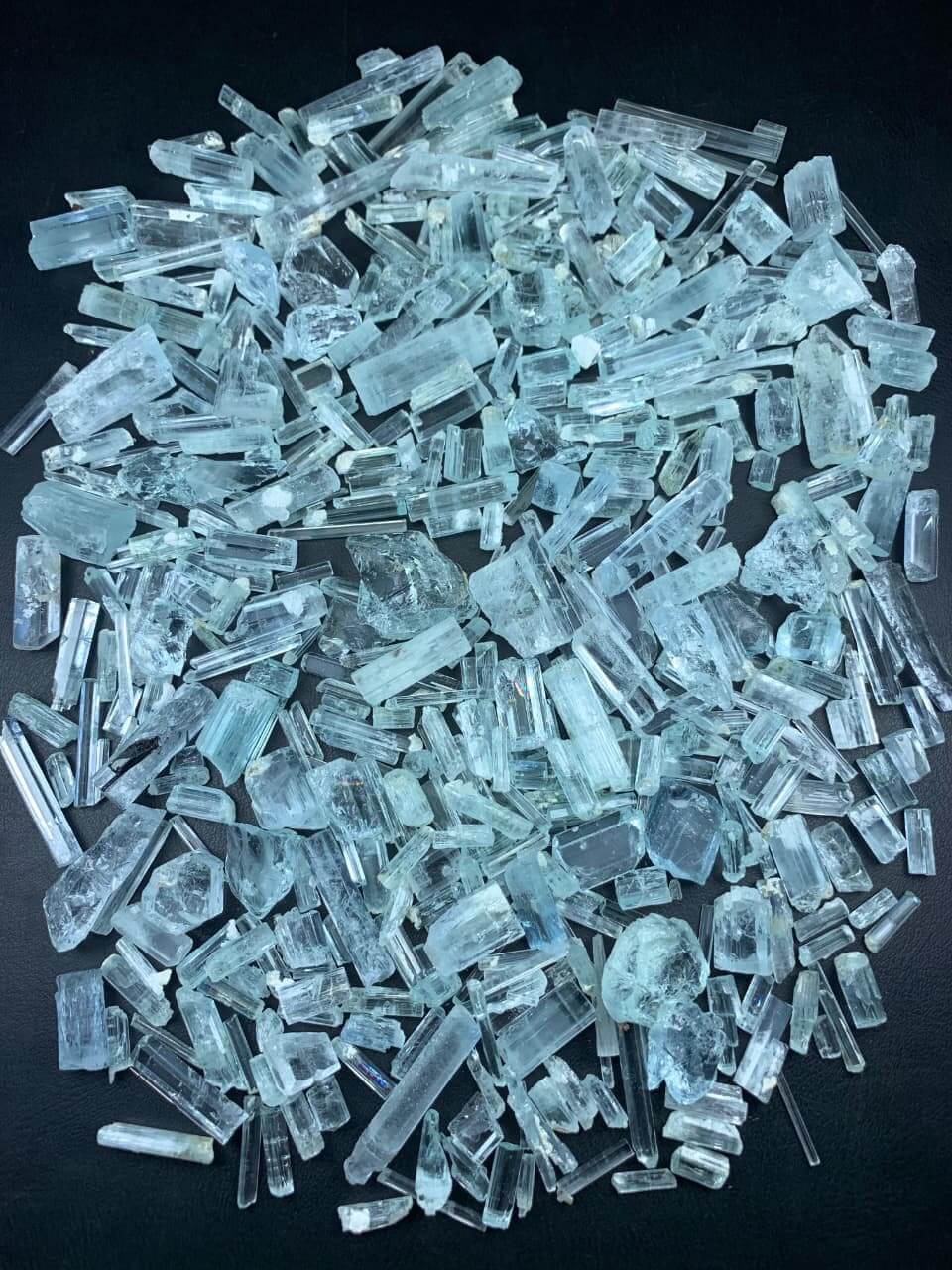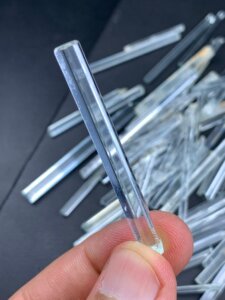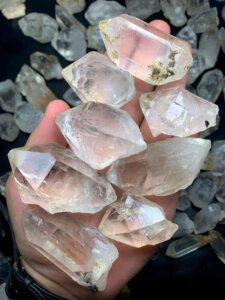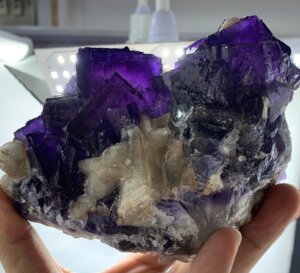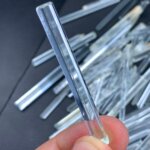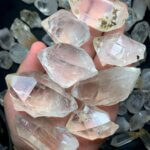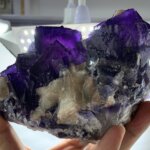Aquamarine crystal — with its serene blue tones reminiscent of the sea — has captivated collectors and jewelry lovers for centuries. Known as the Stone of Courage, this gem embodies tranquility, emotional balance, and timeless beauty. Whether admired as a raw specimen or set in fine jewelry, aquamarine continues to be one of the most sought-after crystals in the world.
In this comprehensive guide, we’ll explore everything you need to know about aquamarine crystals — their history, geological origins, healing and metaphysical properties, identification tips, and how to buy authentic aquamarine specimens online with confidence.
What is Aquamarine Crystal?
Aquamarine is a blue-green variety of the mineral beryl, the same mineral family as emerald and morganite. Its name comes from the Latin words aqua (water) and mare (sea), referring to its ocean-like color and clarity.
Chemically, aquamarine is beryllium aluminum silicate (Be₃Al₂(SiO₃)₆), with traces of iron giving it that signature blue hue. The deeper the blue, the rarer and more valuable the stone.
Quick Facts:
- Mineral Family: Beryl
- Hardness: 7.5–8 on the Mohs scale
- Color Range: Light blue to deep sea blue, sometimes greenish blue
- Transparency: Transparent to translucent
- Major Sources: Brazil, Pakistan, Nigeria, Madagascar, Afghanistan, USA (Colorado)
The History and Symbolism of Aquamarine
For centuries, aquamarine has been cherished by sailors, royalty, and healers alike. In ancient lore, it was considered the treasure of mermaids and was believed to protect sailors from storms at sea.
During the Middle Ages, aquamarine was thought to reveal the truth in relationships and was often used as a symbol of love, courage, and communication. Even today, it’s a popular gemstone for engagement rings and anniversary gifts.
Fun Fact:
Aquamarine is the birthstone for March and the official gem of the 19th wedding anniversary.
Where Aquamarine Crystals Are Found
Some of the finest aquamarine specimens in the world come from Brazil, especially from the Minas Gerais region, known for producing large, flawless crystals. Other notable sources include:
- Pakistan (Skardu, Gilgit-Baltistan): Produces high-clarity aquamarine crystals prized by collectors.
- Afghanistan: Known for deep, icy blue aquamarines from the Hindu Kush mountains.
- Madagascar: Yields both gem-grade and specimen-quality aquamarine.
- USA (Colorado): The Mount Antero region produces stunning crystals loved by American collectors.
These natural deposits form in pegmatite veins, where molten minerals cool slowly underground, allowing large, well-formed crystals to grow.
Physical and Metaphysical Properties
1. Physical Characteristics
Aquamarine’s appeal lies in its clarity, vitreous luster, and color stability. Unlike some gemstones, its color doesn’t easily fade under light. It’s also durable enough for daily wear, making it ideal for jewelry.
2. Healing and Metaphysical Properties
In crystal healing, aquamarine is valued for its calming and balancing energy. It’s believed to:
- Soothe stress and anxiety
- Enhance clear communication
- Promote courage and confidence
- Encourage emotional healing
Many collectors and energy healers use aquamarine crystal clusters or tumbled stones during meditation to connect with inner peace and clarity.
Different Types of Aquamarine Crystals
1. Raw Aquamarine
These are unpolished natural formations often displayed by mineral collectors. Raw specimens show the crystal’s original hexagonal structure and color zoning.
2. Faceted Gemstones
These are cut and polished aquamarine stones used in fine jewelry. They highlight the stone’s brilliance and depth of color.
3. Aquamarine Specimens with Matrix
These are aquamarine crystals still attached to their host rock (usually feldspar or mica) — highly prized by collectors for their natural beauty.
4. Cat’s Eye Aquamarine
A rare variety exhibiting chatoyancy (a light-reflecting “eye” effect) — desirable for unique jewelry pieces.
How to Identify Genuine Aquamarine
Because aquamarine is a valuable gemstone, it’s often imitated by glass or blue topaz. Here are some tips to spot genuine aquamarine crystals:
- Check the Color: Genuine aquamarine has a soft, watery blue hue — not overly vibrant or electric.
- Examine Transparency: Natural aquamarine is clear with minimal inclusions.
- Test Hardness: It ranks 7.5–8 on the Mohs scale. Glass or fake stones scratch more easily.
- Temperature Feel: Aquamarine feels cool to the touch, unlike synthetic glass.
- Professional Certification: Always buy stones that come with a gemological certificate or from reputable dealers.
How to Care for Aquamarine Crystals
Aquamarine is relatively durable but still requires proper care to preserve its brilliance.
Do:
- Clean gently with mild soap and warm water.
- Store separately from harder gemstones (like diamonds) to avoid scratches.
- Use a soft brush to remove dust from crystal crevices.
Don’t:
- Expose to harsh chemicals or ultrasonic cleaners.
- Leave under direct sunlight for prolonged periods (may cause fading over decades).
Buying Guide: Choosing the Right Aquamarine Crystal Online
When purchasing aquamarine — whether as a raw specimen, collector piece, or jewelry stone — consider these important factors:
1. Color
Color is the most important value factor.
- Pale blue: Affordable and elegant.
- Medium blue: Most popular among buyers.
- Deep blue: Rare and expensive (often heat-treated to enhance color).
2. Clarity
Look for eye-clean stones (no visible inclusions). Specimens with visible inclusions or growth lines may still be desirable to collectors.
3. Cut or Shape
For jewelry, popular shapes include oval, emerald cut, cushion, and pear. For specimens, look for well-terminated crystals with minimal damage.
4. Size and Weight
Gemstones are measured in carats, while raw crystals are often measured by grams. Larger, transparent aquamarine crystals are prized by collectors.
5. Source
Aquamarines from Brazil and Pakistan are most highly regarded. Always ask for origin information when buying.
6. Certification
Buy from reputable sellers that provide:
- Gemological certificates
- Authenticity guarantees
- Transparent return policies
7. Trusted Online Platforms
You can find genuine aquamarine crystals and specimens from verified online retailers and marketplaces specializing in natural mineral specimens.
Why Collectors Love Aquamarine Specimens
Aquamarine specimens hold special appeal because of their combination of beauty, clarity, and crystal perfection. They make excellent display pieces for home decor or private collections.
Collectors value aquamarine crystals that:
- Exhibit perfect termination points
- Are attached to matrix rock
- Display multiple crystals in one cluster
- Have intense natural color and transparency
Famous Aquamarine Crystals
Some legendary aquamarines showcase just how magnificent this gem can be:
- The Dom Pedro Aquamarine: Weighing 10,363 carats, it’s the largest cut aquamarine in the world, displayed at the Smithsonian Institution, USA.
- Brazilian Santa Maria Aquamarine: Known for its exceptional deep blue hue, it set the standard for the finest color grade in the trade.
Aquamarine in Jewelry Design
Aquamarine’s elegance and durability make it a favorite among designers. It pairs beautifully with white gold, platinum, and silver, enhancing its cool tone.
Popular designs include:
- Aquamarine engagement rings
- Pendant necklaces
- Statement earrings
- Bracelets featuring raw aquamarine beads
Its subtle color complements any outfit — from casual beachwear to luxury evening attire.
FAQs About Aquamarine Crystal
1. Is aquamarine a rare gemstone?
While not as rare as emerald, high-quality deep blue aquamarine is increasingly scarce and highly valued.
2. What’s the difference between aquamarine and blue topaz?
Aquamarine has a softer, more natural sea-blue hue, while blue topaz tends to have a more vibrant sky-blue tone and is usually heat-treated.
3. Can aquamarine be used in daily-wear jewelry?
Yes. With a hardness of 7.5–8, it’s durable enough for rings, necklaces, and bracelets.
4. Does aquamarine lose color over time?
Genuine aquamarine retains its color very well. Only extreme exposure to sunlight over decades can cause minor fading.
5. How can I tell if my aquamarine is natural or synthetic?
Lab-grown aquamarines are rare. Always buy from trusted dealers with certification to ensure authenticity.
Conclusion: Discover the Timeless Beauty of Aquamarine
Aquamarine crystal captures the calm and mystery of the ocean — a gem that blends natural elegance with spiritual depth. Whether you’re a collector seeking museum-quality specimens or a jewelry lover searching for your next piece, aquamarine offers lasting value and beauty.
Explore our exclusive collection of natural aquamarine crystals and specimens, ethically sourced and hand-selected for clarity, color, and brilliance.
